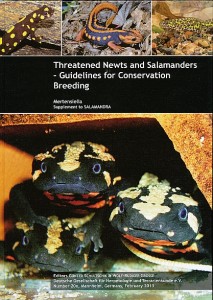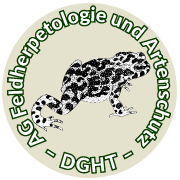Mertensiella Band 20: Gefährdete Molch- und Salamanderarten der Welt
Originaltitel:
Threatened Newts and Salamanders of the World – Captive Care Management / Gefährdete Molch- und Salamanderarten der Welt – Richtlinien für Erhaltungszuchten
Herausgeber: Günter Schultschik & Wolf-Rüdiger Große
Sprache: Englisch und Deutsch
Kurzbeschreibung/Summary
 Approximately two thirds of the more than 7000 known amphibian species on earth are currently considered to be threatened by the IUCN. Of the 650 known species of newts and salamanders, about 430 are more or less exposed to the risk of extinction. These guidelines for captive keeping and breeding of threatened species of Caudata in human care aim at promoting public awareness of respective opportunities and thus contributing to their conservation. Twentytwo threatened Eurasian species and the Neotropical Axolotl are represented in this book. Data on the respective threat status, factors involved in declines, guidance for captive keeping and breeding, as well as aid for the identification of developmental stages are provided. With this presentation of scientific knowledge obtained through captive keeping and breeding of threatened species and observations assembled in their natural habitats, the working group „Urodela“ of the DGHT contributes to the agenda of this herpetological society, namely nature conservation, species protection and species-appropriate captive care.
Approximately two thirds of the more than 7000 known amphibian species on earth are currently considered to be threatened by the IUCN. Of the 650 known species of newts and salamanders, about 430 are more or less exposed to the risk of extinction. These guidelines for captive keeping and breeding of threatened species of Caudata in human care aim at promoting public awareness of respective opportunities and thus contributing to their conservation. Twentytwo threatened Eurasian species and the Neotropical Axolotl are represented in this book. Data on the respective threat status, factors involved in declines, guidance for captive keeping and breeding, as well as aid for the identification of developmental stages are provided. With this presentation of scientific knowledge obtained through captive keeping and breeding of threatened species and observations assembled in their natural habitats, the working group „Urodela“ of the DGHT contributes to the agenda of this herpetological society, namely nature conservation, species protection and species-appropriate captive care.
Erschienen: 2013
ISBN: 9783899735673
Diesen Band bestellen:
Normalpreis: 59,90 EUR (zur Bestellung)
Preis für DGHT-Mitglieder: 39,90 EUR (zur Bestellung)
Inhalt
Das Hardcover-Buch umfasst 178 Seiten und zeichnet sich durch diverse Farbabbildungen und Grafiken aus. Es beschreibt u.a. das Fortpflanzungsverhalten folgender Arten:
- Ambystoma mexicanum
- Paradactylodon persicus
- Paradactylodon gorganensis
- Calotriton asper
- Cynops ensicauda
- Cynops orphicus
- Euproctus montanus
- Euproctus platycephalus
- Laotriton laoensis
- Liua shihi
- Mertensiella caucasica
- Neurergus crocatus
- Neurergus derjugini
- Neurergus kaiseri
- Neurergus strauchii
- Triturus dobrogicus
- Triturus pygmaeus
- Tylototriton asperrimus
- Tylototriton hainanensis
- Tylototriton kweichowensis
- Tylototriton shanjing
- Tylototriton taliangensis
- Tylototriton wenxianensi
 Download als PDF
Download als PDF 

 Posted under:
Posted under: